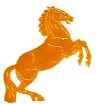 Horsemeat as precious nutrition
Horsemeat as precious nutrition
 Horsemeat is not
very prometed in Germany. To injustice, as we mean, because it has very valuable
characteristics and offers an interesting enriching of the food note.
Purpose of this site is to offer some information about this topic and to
suggest to try out this kind of meat.
Horsemeat is not
very prometed in Germany. To injustice, as we mean, because it has very valuable
characteristics and offers an interesting enriching of the food note.
Purpose of this site is to offer some information about this topic and to
suggest to try out this kind of meat.
In addition, we would like to invite you to think about meat consumption in general, somehow
more.
As for ourself, we really do like horses, and the single tought of slaughtering such
friendly and intimitate animal for meat production is certainly strange.
The arguments with this topic are worthwhile themselves, because meat should not be
a mass product, which is devourated in a careless way. Anyone who eats meat, should spend
some thoughts about of the animal which provided it. And one should take a
stand for the animals as activeley as possible
(please see also horses and humans)
How to describe horsemeat?
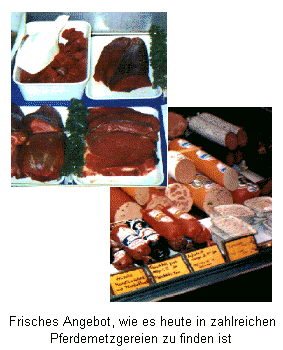
- the taste is generally appreciated, something between beef and venison
- fixed, but tender consistency (particularly the meat from foals)
- dark, red colour (particularly the meat of old horses)
- horsemeat is darker than beef and has only an very little part of fat
- in raw condition it is somehow fibrously and requires an special, adequate
handling in processing
What are the horsemeat products?
Classical German
horsemeat products are probably broiled meat balls and special sausages. The
quality of this products is actually better than all the comparable of this kind.
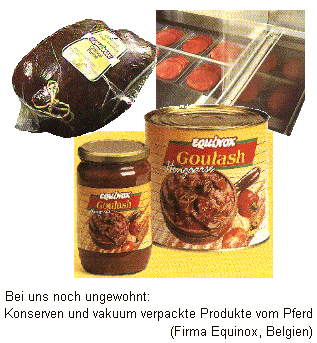 Beyond that almost well-known butcher products there are a rich assortment of fresh and
processed meat products. Fresh meat will be braised or roasted but rarely boiled in water.
Smoked ham and tongue are specialities one should try out once.
Beyond that almost well-known butcher products there are a rich assortment of fresh and
processed meat products. Fresh meat will be braised or roasted but rarely boiled in water.
Smoked ham and tongue are specialities one should try out once.
Meat and sausages are usually offered freshly at horse butcher's shops. Some
restaurants also offer the possibility of becoming acquainted with horsemeat dishes. In
other countries memories and vacuum packed products are also usual. They are common in the
stock of the supermarkets in France and Begium.
For more information see also:
Why horsemeat is healty?
-
It has very low of fat and precious components:
| type of meat |
fat (%) |
protein (%) |
kalcium (%) |
energy (kcal) |
| horse (average) |
02,7 |
20,6 |
0,013 |
117 |
| beef (very lean) |
07,2 |
20,0 |
0,009 |
150 |
| beef (average) |
22,1 |
17,2 |
0,008 |
273 |
The table shows that the fat content of horsemeat makes only half the content of the
beef's with comparable nutritional value. These extremly low value of
fat cannot be achieved from most other types of meat.
From a purely medical view the consumption of horsemeat is very
recommendable, particulary in prevention against artery illness and
cardiovascular diseases.
An complete list of all chemical components of horsemeat can be found
here. 
-
Horsemeat is not a mass product:
In Germany, horses are generally not raised for slaughtering, but held for other
purposes. Therefore, horsemeat is not optimized on rational production.
In most cases, horses live under better conditions than other animals. They enjoy
a healty feeding, oriented on physical efficiency. Contrary to most other animals
in agriculture, the feeding and living conditions of horses are publicly controllable.
In some contries horses are of course raised for meat production. This occurs usually
under extensive conditions.
For more detailed information see horsebreeding for meat production.
Some facts about horsemeat production:
Perhaps only a few people may know that horsemeat belongs to the most
interesting products of the meat industry.
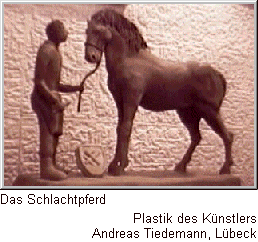 As differently as its importance in
diffrent culture areas, so eventfully is its history as food.
As differently as its importance in
diffrent culture areas, so eventfully is its history as food.
The way horsemeat
is produced, are very different. In Germany and some other european countries its
importance as food is quite small. The produced quantities are pretty steady low. In
Germany, approximatly 4,000 tons horsemeat are produced each year,
for wich about 15,000 horses are slaughtered. This seems to be
much, however, compared with the cattle slaughtering, the natioanl production of horsemeat
is very little.
Each year, a considerable overstock of slaughter-horses remains, horses which are exported
alive in an irresponsible way.
In Germany horse slaughtering is usually done in small family businesses, in which the
occupation of the horse butcher kept as traditional handicraft.
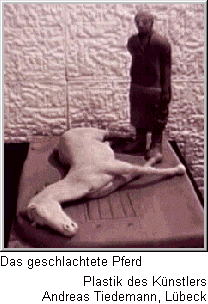 Many of
them show that one can manufacture butcher certifications of high quality, without making
the animals suffer. It may be very interesting for you to inform yourself about this type
of butcher generation, since the local manufacture work is often is combined with modern
technique and high hygienic guidelines:
Many of
them show that one can manufacture butcher certifications of high quality, without making
the animals suffer. It may be very interesting for you to inform yourself about this type
of butcher generation, since the local manufacture work is often is combined with modern
technique and high hygienic guidelines:
In some European and non-European countries, the consumption of horsemeat is substantially
higher than in Germany. This requirement is covered partly by horsebreeding
for meat production. To raise horses for this purpose seems pecular for our culture, but
under other countries conditions it may be sensible. For this reasons, we have collected
some related informations:
Because horsebreeding countries and countries, where horsemeat is consumed on large
amounts are not always the same, there is an considerable amount of trade with
horsemeat and also, particulary in europe, with livestock horses for slaughter.
So slaughterbound horses sometimes were transported over long distances. In the past,
such transports were the subject of protests in the public by animal protection
organisations. Today there are strongly controlled rules by the European Union for
any treatment of slaughterbound animals as such as their transports.
Horsemeat consumption and cruelty to animals are totaly apart from each other.
Violations against animal protection disparages horsemeat as a valuable foodstuff.
Therefore today also transporting companies as such as slaughtering plants are
interested in an successful and up to date animal protection.
Slaughtering plants are working with modern equipment and are corresponding to standards
of the European Union. So an constant control of quality is guaranteed. Modern slaughtering
plants don't purchasing old, starved nags any more but only slaughterbound colts and
young, feeded horses as such as muscular adult horses in best healty condition.
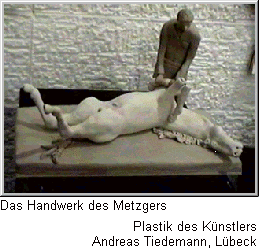
Two main suppliers of slaughterbound horses in Europe are Poland and Romania. For both
countries the horsemeat business got an considerable economical importance and is
therefore also important for the inhabitants. The origin of the animals is split up
into two different parts: The first one are young slaughterbound horses and colts,
wich are raised for meat production. In this cases, the feeding of slaughterbound horses
and colts opens the possibility of some extra money for rather small farms, wich raised
the parent animals as working horses. The second part are adult animals, wich are
selling to the meat market after their usage as working horses. So there is a further
sensible economical use for this animals.
In contrary to moral objections somebody should take into account that particulary in
agricultural embossed regions horses are economical determined. It involves much more
animal protection to use their meat as long as they are in an muscular and healty
condition than an endless and often painful usage of over-aged working horses. For this
reason in the past the first horse butcheries in Europe were founded by animal protectors.
The consumption of meat has an cultural value. An respectful and careful treatment
of all animals for slaughter belongs to the quality of meat. As for the horses,
it seems, that this requirement is better fulfilled than for other animals.
But some negative appearences remains, which must be overcome step by step.
The authors of this site are activeley engaged for a positive developement.
 back to start page
back to start page
 back to site map
back to site map


 Horsemeat as precious nutrition
Horsemeat as precious nutrition
 Horsemeat is not
very prometed in Germany. To injustice, as we mean, because it has very valuable
characteristics and offers an interesting enriching of the food note.
Purpose of this site is to offer some information about this topic and to
suggest to try out this kind of meat.
Horsemeat is not
very prometed in Germany. To injustice, as we mean, because it has very valuable
characteristics and offers an interesting enriching of the food note.
Purpose of this site is to offer some information about this topic and to
suggest to try out this kind of meat.
 Beyond that almost well-known butcher products there are a rich assortment of fresh and
processed meat products. Fresh meat will be braised or roasted but rarely boiled in water.
Smoked ham and tongue are specialities one should try out once.
Beyond that almost well-known butcher products there are a rich assortment of fresh and
processed meat products. Fresh meat will be braised or roasted but rarely boiled in water.
Smoked ham and tongue are specialities one should try out once.

 As differently as its importance in
diffrent culture areas, so eventfully is its history as food.
As differently as its importance in
diffrent culture areas, so eventfully is its history as food.
 Many of
them show that one can manufacture butcher certifications of high quality, without making
the animals suffer. It may be very interesting for you to inform yourself about this type
of butcher generation, since the local manufacture work is often is combined with modern
technique and high hygienic guidelines:
Many of
them show that one can manufacture butcher certifications of high quality, without making
the animals suffer. It may be very interesting for you to inform yourself about this type
of butcher generation, since the local manufacture work is often is combined with modern
technique and high hygienic guidelines:

 back to start page
back to start page
 back to site map
back to site map